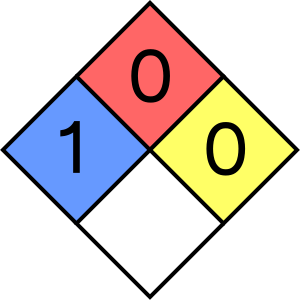SODIUM THIOSULFATE ANHYDROUS
Basic information
- Chemical formula(s): \({\rm Na_2S_2O_3 \cdot xH_2O}\)
- Other names: disodium thiosulfate, thiosulfuric acid, disodium salt, sodium hyposulfit
- CAS: 7777-98-7
- International Chemical Safety Card (ICSC): 1138
- Flammability: no
- Description: white or colourless crystalline substance that dissolves well in water
NFPA 704 (fire diamond)

- Health (blue): 1 - exposure would cause irritation with only minor residual injury.
- Flammability (red): 0 - will not burn under typical fire conditions, will not burn in air unless exposed to a temperature of 820 °C for more than 5 minutes.
- Instability–reactivity (yellow): 0 - normally stable, even under fire exposure conditions, and is not reactive with water.
- Special notice (white): -
Hazard statements
| Code | Phrase |
|---|---|
| H315 | causes skin irritation |
| H319 | causes serious eye irritation |
| H335 | may cause respiratory irritation |
Precautionary statements
| Code | Phrase |
|---|---|
| P261 | avoid breathing dust/fume/gas/mist/vapours/spray |
| P264 | wash … thoroughly after handling |
| P271 | use only outdoors or in a well-ventilated area |
| P280 | wear protective gloves/protective clothing/eye protection/face protection |
| P302+P352 | IF ON SKIN: wash with soap and water |
| P304+P340 | IF INHALED: remove victim to fresh air and keep at rest in a position comfortable for breathing |
| P305+P351+P338 | IF IN EYES: rinse continuously with water for several minutes, remove contact lenses if present and easy to do, continue rinsing |
| P312 | call the ETH Emergency Desk: +41 44 342 11 88 (from mobile) or 888 (from landline) if you feel unwell |
| P321 | specific treatment (see the label) |
| P332+P313 | IF SKIN IRRITATION OCCURS: get medical advice/attention |
| P337+P313 | IF EYE IRRITATION PERSISTS: get medical advice/attention |
| P362 | take off contaminated clothing |
| P403+P233 | store in a well ventilated place, keep container tightly closed |
| P405 | store locked up |
| P501 | dispose of contents/container to HCI-Shop |
Protective measures
Gloves
Occupational Safety and Health Act of 1970 and OSHA Glove Selection Chart do not provide recommendation on gloves for handling sodium thiosulfate. California State University categorizes gloves into four protection levels (excellent, good, fair, poor (not recommended)) for given chemical. The levels of protection against sodium thiosulfate for four types of gloves are:
- Neoprene: N/A.
- Natural latex or rubber: good.
- Buthyl: N/A.
- Nitrile: good.
Safety goggles
- Always wear safety goggles when handling sodium thiosulfate. Corrective glasses are not considered safety googles.
- Handle sodium thiosulfate inside the fume hood only (with exception of moving the closed bottle to and from the storage cabinet).
Clothing
- Wear long trousers and fully covered shoes.
- Contact lenses are forbidden while working with chemical substances, even in combination with safety glasses.
- Do not wear cosmetics.
- Do not wear synthetic clothing while working with flammable liquids or gases or when a hazard is present as these materials tend to melt and stick to exposed skin.
- Do not wear headphones.
Spill management
- Use personal protective equipment.
- Avoid dust formation, avoid breathing dust.
- Avoid breathing vapors or mist.
- Ensure adequate ventilation.
- Evacuate personnel to safe areas.
- Sweep up without creating dust and arrange disposal.
- Do not let it enter drain.
- If a spill happened outside the fume hood (on the floor or desktop) contact Dr Jakub Tkaczuk (+41 44 632 31 62) and the ETH Emergency Desk (+41 44 342 11 88 from mobile or 888 from landline).